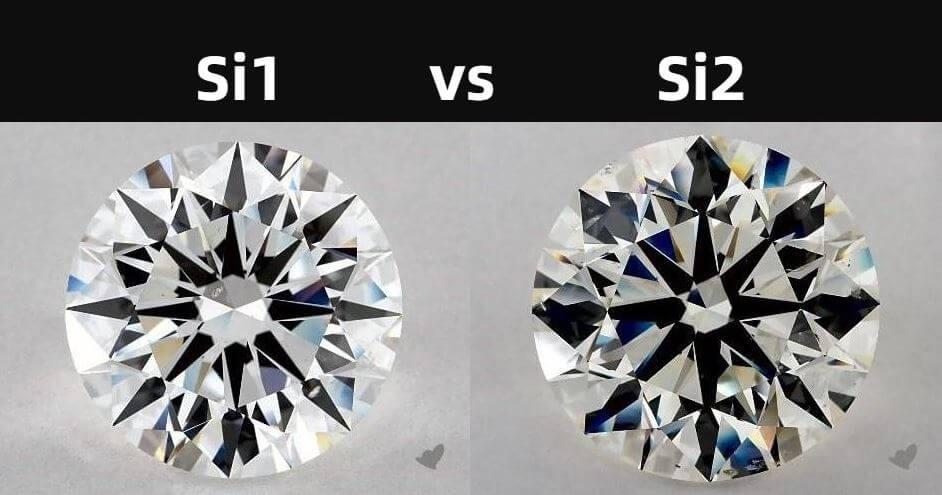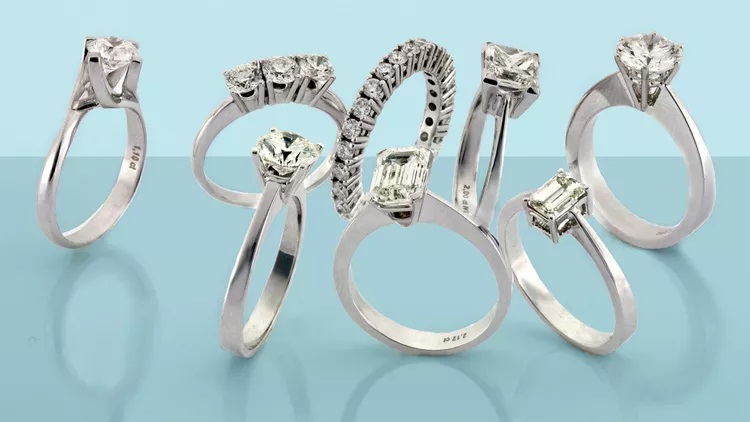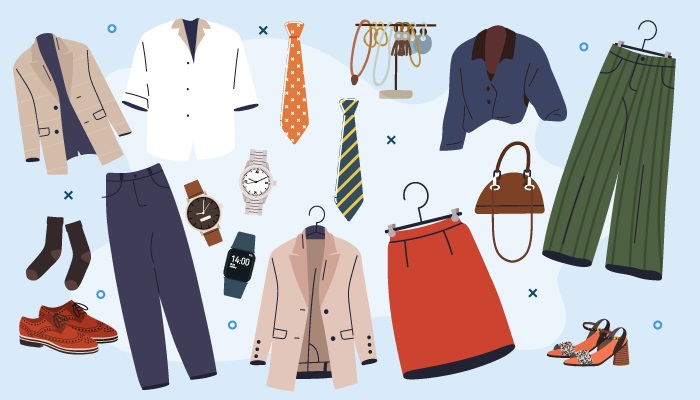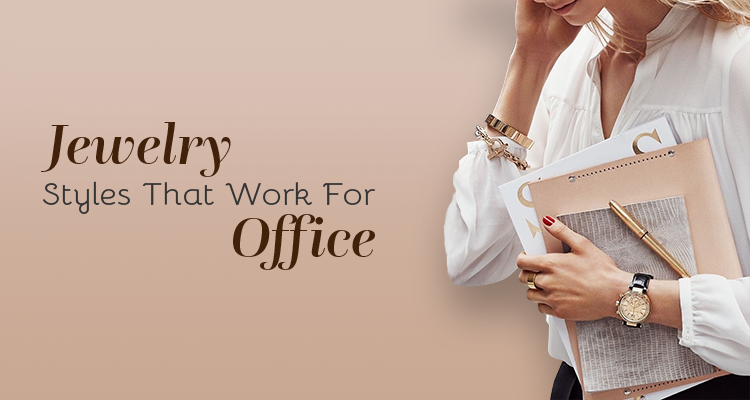When it comes to choosing a diamond, clarity is one of the vital factors to consider. Among the various clarity grades, SI1 (Slightly Included 1) and SI2 (Slightly Included 2) are commonly encountered options. However, understanding the differences between SI1 and SI2 diamonds is crucial in making an informed and confident diamond purchase. In this article, we delve into the quality distinctions, price differences, and ideal applications for SI1 and SI2 diamonds. Additionally, we provide valuable shopping tips for those considering lower clarity engagement rings.
Quality Difference: SI1 vs. SI2 Diamonds
SI1 and SI2 diamonds fall within the “Slightly Included” range, indicating the presence of internal characteristics (inclusions) that are visible under 10x magnification. While both grades feature inclusions, there are noticeable quality differences between the two.

SI1 Diamonds: SI1 diamonds typically have fewer and less visible inclusions compared to SI2 diamonds. These inclusions are often smaller, less noticeable, and may require closer examination to detect. SI1 diamonds offer a good balance between clarity and value, making them an attractive choice for those seeking a diamond with a reasonable price point and a high-quality appearance.
SI2 Diamonds: SI2 diamonds have slightly more visible inclusions compared to SI1 diamonds. However, the appearance and visibility of inclusions can vary widely within the SI2 grade. Some SI2 diamonds may have inclusions that are easily visible, while others may possess inclusions that are less noticeable. When selecting an SI2 diamond, it’s important to carefully examine the stone and evaluate the visibility and impact of its inclusions.
Price Difference: SI1 vs. SI2 Diamonds
Due to the differences in clarity quality, SI1 diamonds are generally priced higher than SI2 diamonds. The reduced visibility and smaller size of inclusions in SI1 diamonds contribute to their higher price point. However, the price difference between SI1 and SI2 diamonds can vary depending on other factors such as carat weight, cut, color, and overall diamond quality.
Ideal Applications: When to Choose SI1 or SI2 Diamonds
The choice between SI1 and SI2 diamonds ultimately depends on personal preferences, budget considerations, and the desired visual effect. Here are some ideal applications for each clarity grade:
SI1 Diamonds: SI1 diamonds are an excellent choice for those seeking a balance between quality and affordability. They are particularly suitable for engagement rings or jewelry pieces where clarity is an important factor. SI1 diamonds often provide a visually appealing appearance with minimal visible inclusions, making them a popular choice for those who desire a high-quality diamond without the premium price associated with higher clarity grades.
SI2 Diamonds: SI2 diamonds are ideal for those who are budget-conscious and prioritize a larger carat size or other aspects such as cut or color. While SI2 diamonds may have more visible inclusions, careful selection can yield stones with inclusions that are not readily apparent to the naked eye. They can be an excellent choice for individuals who value size and overall diamond presence over the microscopic inclusions.
Shopping Tips for Buying Lower Clarity Engagement Rings
Seek Expert Advice: Consult with a reputable jeweler or gemologist who can guide you through the diamond selection process. They can provide valuable insights, help you understand the visibility and impact of inclusions, and assist in finding the best SI1 or SI2 diamond that meets your preferences and budget.
Optimize Cut and Shape: A well-cut diamond with excellent proportions can enhance its brilliance and minimize the visibility of inclusions. Focus on selecting a diamond with an excellent cut and a shape that suits your personal style.
Evaluate Inclusions Carefully: When examining SI1 or SI2 diamonds, pay close attention to the size, location, and visibility of the inclusions. Opt for diamonds with inclusions that are less noticeable or strategically positioned to be hidden by prongs or facets.
Consider the Overall Appearance: Assess the diamond’s overall appearance and how it appeals to your eye. Remember that individual preferences vary, and what may be acceptable to one person may not be to another. Choose a diamond that captivates you and meets your desired visual effect.
Compare Prices: Compare prices between SI1 and SI2 diamonds to understand the cost difference and determine what fits within your budget. Keep in mind that other factors such as cut, carat weight, and color will also impact the diamond’s price.
Obtain Certification: When purchasing a diamond, always insist on a reputable diamond grading certificate from a recognized gemological laboratory. This certification ensures that the diamond’s quality, including its clarity grade, has been evaluated by unbiased experts.
Additional Considerations When Choosing SI1 or SI2 Diamonds
Transparency: In addition to evaluating the visibility of inclusions, consider the overall transparency of the diamond. Some SI2 diamonds may have inclusions that affect the transparency and brilliance of the stone more than others. Choose a diamond with good transparency, as it will have a positive impact on its overall appearance.
Setting Style: The choice of setting can influence the visibility of inclusions. Certain settings, such as bezel or halo settings, can partially or fully conceal inclusions, making SI2 diamonds a viable option. Discuss different setting options with your jeweler to maximize the beauty of your chosen diamond.
Personal Style and Preferences: Ultimately, your personal style and preferences should guide your decision. If you have a strong preference for a higher clarity diamond and are willing to invest more, an SI1 diamond may be the better choice for you. On the other hand, if you prioritize factors like size or color and are comfortable with slightly more visible inclusions, an SI2 diamond might be a more suitable option.

Trustworthy Retailer: When purchasing lower clarity diamonds, it’s essential to work with a reputable and trustworthy retailer. Choose a jeweler or diamond dealer with a good reputation, certifications from reputable grading labs, and transparent policies regarding diamond quality and return policies. This ensures that you are getting accurate information about the diamond’s clarity and that you can make an informed purchase.
Conclusion
Understanding the differences between SI1 and SI2 diamonds empowers buyers to make well-informed decisions when selecting lower-clarity engagement rings or other diamond jewelry. While SI1 diamonds generally offer better clarity quality and command a higher price, SI2 diamonds can provide an attractive option for those seeking a larger carat size or prioritizing other diamond attributes.
Ultimately, the choice between SI1 and SI2 diamonds depends on personal preferences, budget considerations, and the desired visual effect. By considering the quality distinctions, price differences, and ideal applications for each clarity grade, individuals can confidently choose a diamond that aligns with their needs, ensuring a beautiful and meaningful symbol of love and commitment.…

